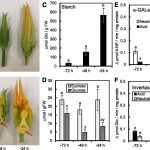Coregulation of Cannabinoid and Terpenoid Pathways
Many governments have recently enacted laws that allow for the legalization of cannabis for medical and/or recreational p urposes. Unfortunately, specific labeling regulations with regard to the composition of active ingredients, serving sizes, and recommended doses are woefully lacking. The capitate-stalked glandular trichomes of Cannabis sativa (cannabis), situated on the surfaces of the bracts of the female flowers, are the primary site for the biosynthesis and storage of resins rich in cannabinoids and terpenoids. Zager et al. (10.1104/pp.18.01506) have profiled nine commercial cannabis strains with purportedly different attributes, such as taste, color, smell, and genetic origin. Glandular trichomes were isolated from each of these strains, and cell type-specific transcriptome data sets were acquired. The cannabinoids and terpenoids in flower buds were also quantified. These data sets enabled the high-resolution differentiation of strains by providing complementary information. Integrative analyses revealed a coexpression network of genes involved in the biosynthesis of both cannabinoids and terpenoids. Terpene synthase genes involved in the biosynthesis of the major monoterpenes and sesquiterpenes routinely assayed by cannabis testing laboratories were identified and also functionally evaluated. This study lays the groundwork for developing a better understanding of the complex chemistry and biochemistry underlying resin accumulation across commercial cannabis strains.
urposes. Unfortunately, specific labeling regulations with regard to the composition of active ingredients, serving sizes, and recommended doses are woefully lacking. The capitate-stalked glandular trichomes of Cannabis sativa (cannabis), situated on the surfaces of the bracts of the female flowers, are the primary site for the biosynthesis and storage of resins rich in cannabinoids and terpenoids. Zager et al. (10.1104/pp.18.01506) have profiled nine commercial cannabis strains with purportedly different attributes, such as taste, color, smell, and genetic origin. Glandular trichomes were isolated from each of these strains, and cell type-specific transcriptome data sets were acquired. The cannabinoids and terpenoids in flower buds were also quantified. These data sets enabled the high-resolution differentiation of strains by providing complementary information. Integrative analyses revealed a coexpression network of genes involved in the biosynthesis of both cannabinoids and terpenoids. Terpene synthase genes involved in the biosynthesis of the major monoterpenes and sesquiterpenes routinely assayed by cannabis testing laboratories were identified and also functionally evaluated. This study lays the groundwork for developing a better understanding of the complex chemistry and biochemistry underlying resin accumulation across commercial cannabis strains.



